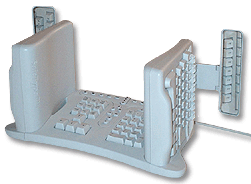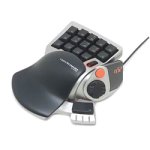 I recently upgraded to a Mac Pro, which I justified to myself thusly:
I recently upgraded to a Mac Pro, which I justified to myself thusly:
1. I’m doing effects for The Movie, and Motion runs much faster on it. (In truth, I only did one effect in the final cut.)
2. My G5 was actually slower than my laptop.
3. As a writer, I needed a quieter computer.
4. I deserve to throw some of my Hollywood money around.
The new computer is great, and almost all of my software works perfectly on it. Unfortunately, I’ve had some hiccups with my input devices.
 As I’ve [blogged about](http://johnaugust.com/archives/2004/my-new-keyboard-setup), I have a strange keyboard. It looks impossible to use, but I’m actually much faster typing on it than a traditional keyboard, with the added bonus that my arms don’t go numb in the middle of the night.
As I’ve [blogged about](http://johnaugust.com/archives/2004/my-new-keyboard-setup), I have a strange keyboard. It looks impossible to use, but I’m actually much faster typing on it than a traditional keyboard, with the added bonus that my arms don’t go numb in the middle of the night.
The Mac Pro isn’t thrilled with my keyboard, which connects through a serial-to-ADB dongle. On restarts, the computer asks me to confirm the keyboard layout, suspicious that I’ve swapped in a Klingon model. Nevertheless, it produces the correct letters every time.
While my odd keyboard is great for typing, it’s singularly awful for key commands, like Copy, Paste and Undo. While one’s fingers can always find the right keys to form words, there’s something different about multi-key combinations. It just doesn’t happen consistently.
 That’s why I’ve been using a little gaming keypad, the Nostromo N52 by Belkin. Using the software that came with it, I set up keys for Copy, Paste and all the useful shortcuts one is likely to use. With my right hand on the mouse, and my left on the Nostromo, I’m an editing machine.
That’s why I’ve been using a little gaming keypad, the Nostromo N52 by Belkin. Using the software that came with it, I set up keys for Copy, Paste and all the useful shortcuts one is likely to use. With my right hand on the mouse, and my left on the Nostromo, I’m an editing machine.
But the software for the Nostromo refuses to work with the Mac Pro.
At first, I wondered if I could live without it. I thought my fingers would stop reaching for the non-functioning keypad, but they wouldn’t. Thinking I was copying something, I’d be left with a single lower-case g, which is how the computer decided to interpret the chatter from the orphaned device.
Belkin hasn’t upgraded the drivers in years, so I’m not holding my breath that there will suddenly be a new version for Intel Macs like mine. One guy has taken it upon himself to create his own drivers, but it looks like even he’s given up.
Fortunately, there’s a program called [ControllerMate](http://orderedbytes.com/controllermate/) which can handle the Nostromo. For $15, it’s almost as good as free, and can do a lot of things that the Belkin software couldn’t. Like confound the hell out of me.
ControllerMate has an elaborate flow-chart-style programming language which looks great but is almost impenetrable. How do you assign a keystroke to a button? It’s as easy as…
1. Pick the controller from the list.
2. Double-click it to open the available controller buttons.
3. Press the actual button on the device to indicate which virtual button it corresponds to.
4. Drag the virtual button to the programming area.
5. But first, you might want to make a new programming page. Or a group. Why? You won’t know until you need it.
6. Now, pull down the menu to outputs, and select “Keystroke” or “Single Key.” What’s the difference? I couldn’t tell you, except that Single Key seems to work and Keystroke locked up my machine in a beeping loop.
7. Open the virtual keyboard palette and drag the desired key to the well, then add any modifier keys.
8. Then drag the whole thing to the programming area, and attach it to the virtual button.
9. Test to see if it works.
Repeat for all of the other keys. Uggh.
To be fair, there’s a benefit to all this abstraction. You can create some pretty elaborate logic by nesting groups and pages, so that hitting one key while another key is pressed performs a special function. But it’s a lot of work to get to Copy and Paste.
My fingers are just happy to be back on autopilot. Just in the course of writing and posting this blog, they’ll have reached for the Nostromo fifteen times. Which is fifteen times less I’ve had to curse under my breath.